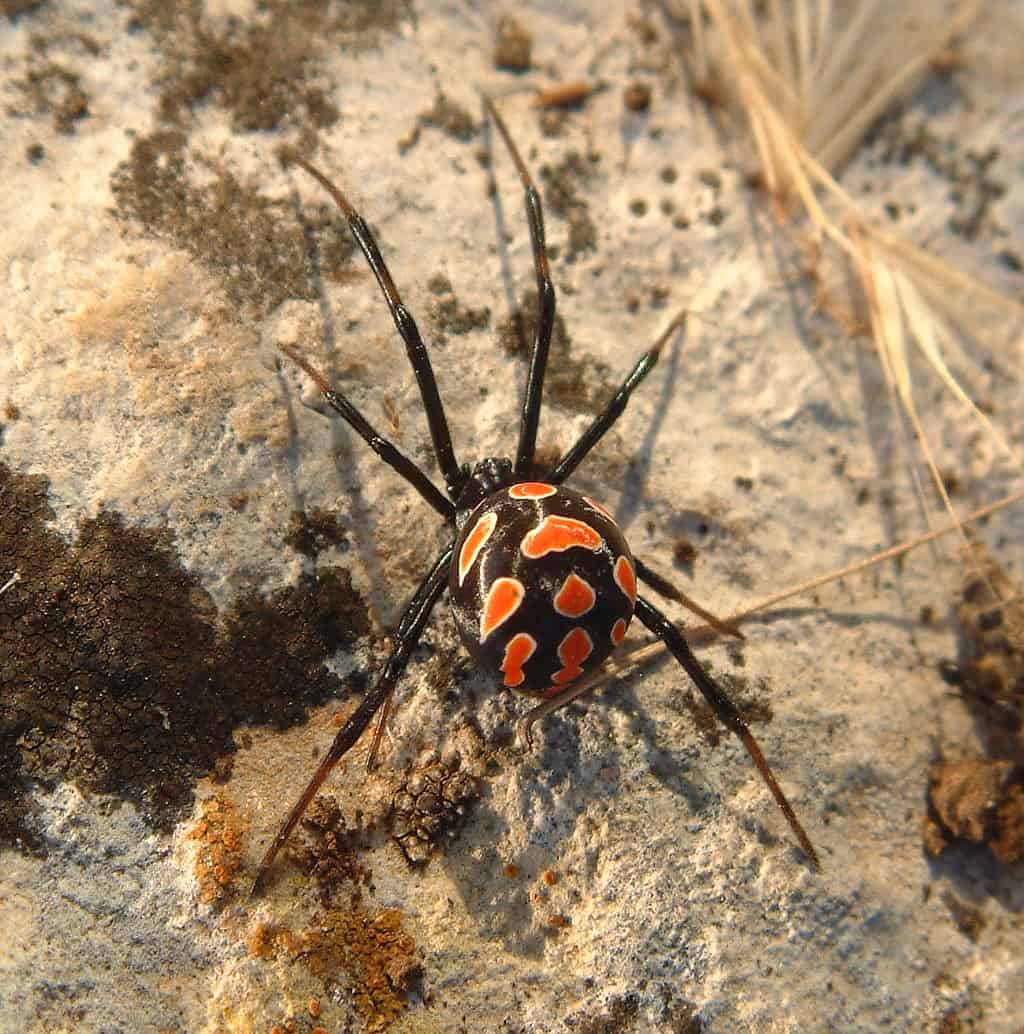
Beware of the Black widow spider! Once you get bitten, its venom spreads to other parts of the body, damaging muscles, nerves, and other organs. However, experts say the black widow spider is really, rather shy, when they bite people it’s in self-defense the majority of the time. Most of the time, the people who got a taste of its poison probably disturbed it or made it mad. Black widow spider facts to remember in case you run into one in the future!
These combed-footed spiders are also famous for their unusual “sex cannibalistic” behavior. They devour their partner after mating, which is probably how they got their name. The black widow spider, like many other spiders, feeds on insects trapped in their webs. As she waits for her prey, the female spider hangs upside down from her web. The bright red hourglass designs seen on their abdomen serve as a visible warning to potential predators that she is toxic.
Many people and animals are afraid of black widow spiders, and they should be. These shiny, plump creatures, from the spider family Theridiidae, are some of the most venomous spiders in North America. What makes them especially infamous is their extremely lethal and potent venom, and yet, at the same time, the very same venom, when used in a different way, can save human lives. Their venom is used in drugs to treat diseases. Some of these diseases include lung cancer, Alzheimer’s disease, and heart fibrillation.
Did our short description of facts make you want to know more about this small but deadly creature? Then check out our 30 black widow spider facts below!
- The body of a female black widow spider is around 2.5 centimeters or one inch long.
- A male black widow spider’s body is about half of the female’s size, about 1.25 centimeters or 0.5 inches.
- Like most spiders, they have eight legs.
- A widow spider has 32 species.
- Black widow spiders have a lifespan of around one to three years.
- Black widow spiders are arachnids.
- They are also called southern black widows.
- Latrodectus is the scientific name of the black widow spider.
- It has an average weight of around 0.035 ounces.
- Black widow spiders are found in temperate regions around the world.
- Female black widow spiders have an orange or red hourglass marking on their abdomen.
- The name “black widow,” came from the female habit of eating and killing the male spider.
- Black widow spiders’ babies are called spiderlings.
- They typically prey on a variety of insects.
- The black widow spider is a member of the spider family Theridiidae. They are commonly referred to as comb-footed spiders.
- Black widow spiders have poor eyesight and they rely on web vibrations to trap prey.
- Their legs are covered with an oily substance which inhibits them from being caught in their own web.
- Black widow spiders are not aggressive, and they only bite for defense.
- The male black widow spider sometimes rearranges and destroys the female’s web to make it less attractive to other males.
- Male black widow spiders choose their mate by determining if the female spiders have already eaten.
Female black widow spiders eat the male after mating.
Regarded as a “sexual cannibal,” the female can kill and eat the male spider after mating — hence its name. Some scientists say that the female black widow spider eats the male spider to get the protein inside of it, which will be important to the eggs that she will develop. This also explains why the male spider has a very short lifespan.
Only the female black widow spider is venomous.
Only the female widow spider has venom glands, and their poison can be dangerous to other animals, including humans. Although the black widow spiders seldom bite humans, their venom is 15 times more potent than a rattlesnake’s poison. Their venom can cause nausea, aches, and diaphragm paralysis.
Black widow spiders create silk-like webs.
Black widow spiders prefer to create their silk-like, tangled, and irregular webs in dark and covered areas like under logs and drain pipes. They often hang in the center of the web and wait for their prey to get stuck. Once the black widow spider has its prey, it will bite, sting, and wrap the prey with a web.
Black widow spiders lay around 250 to 750 eggs.
The female black widow spiders lay eggs usually during summer. They lay around 250 to 750 eggs. They incubate those eggs for 20 days in a papery, round sac attached to the spider’s web. Spiderlings, which are white and orange, stay on the web for 30 days. However, due to their cannibalistic behavior, only a few survive.
Not all black widow spiders are black.
Although most of them are colored like their name, not all species are black, some are red and brown. Other species of black widow spiders include the northern, southern, and western black widow spiders. In other places, you’ll find the European black widow and the Australian redback black widow.

Black widow spider species have different markings.
Generally, female black widow spiders are identified by the hourglass design on their body. However, not all females have this type of marking. The northern black widow spiders have “broken” hourglass designs, or a series of broken red dots, while the southern one has a complete hourglass design. On the other hand, the male southern and northern black widow are typically brown with white markings.
Black widow spiders are nocturnal.
During the day, black widow spiders hide, or sometimes spin their webs. At nighttime, they roam around their webs to hunt their prey. Apart from being nocturnal, they are also shy creatures, they live solitarily, and only socialize during breeding.
Black widow spiders can survive cold months.
During cold months, black widow spiders go into an overwintering state. This means, they wait for the winter season to pass. Their metabolic rate helps them conserve energy, adapt, and survive the cold months. Black widow spiders tuck in their legs and sleep.
Black widow spiders are often mistaken with false widow spiders.
Even though the black widow spider and false widow spiders share some similarities, the black widow spider can still be clearly distinguished from false widow because of its unique markings. Furthermore, the black widow spiders are larger, and their bites are more painful than the false widow spider.
Black widow spiders help balance the ecosystem.
Despite their infamous tendencies, or what might other people think about them, black widow spiders play an important role in the ecosystem.
They consume insects that carry diseases like flies and mosquitoes, pests that destroy plants and trees like beetles, locusts and caterpillars, and grasshoppers, keeping their numbers in check. This provides us a balanced ecosystem. Every organism has its purpose.
Was this page helpful?
Our commitment to delivering trustworthy and engaging content is at the heart of what we do. Each fact on our site is contributed by real users like you, bringing a wealth of diverse insights and information. To ensure the highest standards of accuracy and reliability, our dedicated editors meticulously review each submission. This process guarantees that the facts we share are not only fascinating but also credible. Trust in our commitment to quality and authenticity as you explore and learn with us.


